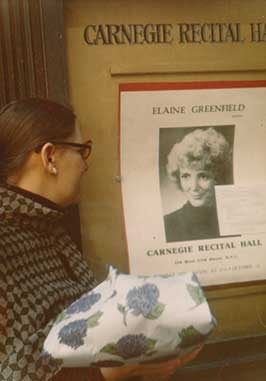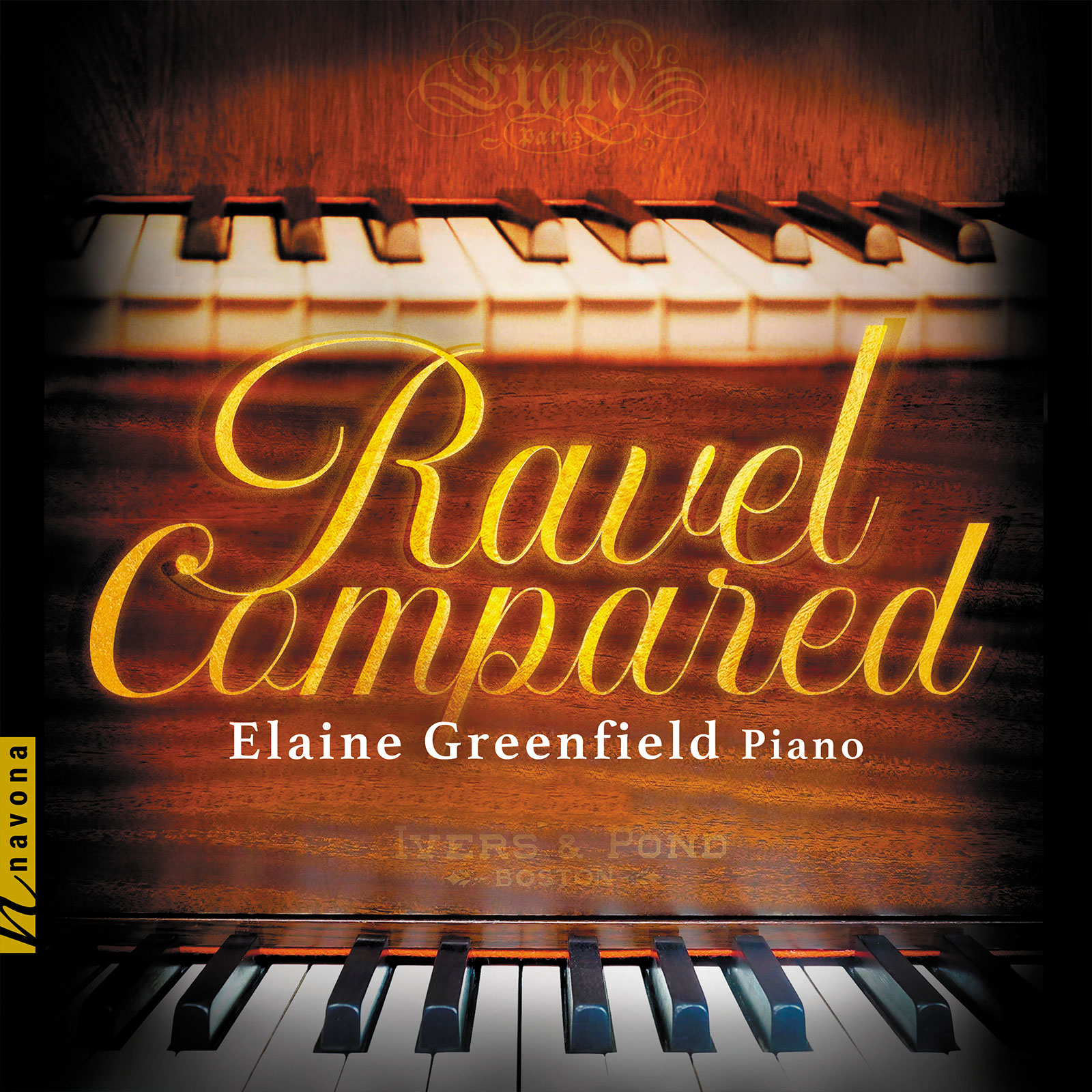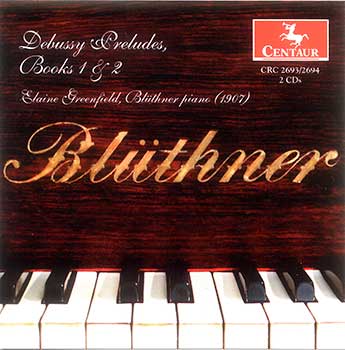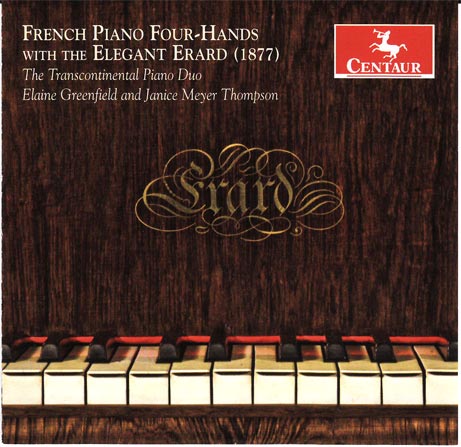REVIEWS AND TESTIMONIALS
Menahem Pressler
A Letter dated September 21, 2004:
Dear Mrs. Greenfield,
Thank you for sending me your record. It’s beautiful and for me very meaningful. Debussy is an important part of my life. It is people like you that make me continue and grateful I am able to give hope to see you again at Adamant.
With my best wishes and congratulations,
Menahem Pressler
Clavier Magazine
Debussy Preludes, Bks. 1 & 2
Claude Debussy Preludes Books 1 & 2
Elaine Greenfield (piano)
Centaur – 2693/4 (CD)
Greenfield’s performances on the two-CD set are impeccable, the result of years of study. Debussy’s intent becomes clear, and for the first time I realized how this music was meant to sound….
….ethereal qualities in the music seem effortless. “La terrasse des audiences du clair du lune” from book two, is the nearest thing to moonlight in sound I’ve heard…
….a slightly veiled, voluptuous sound
PHILIPPA KIRALY – Clavier Magazine / Dec. 2005
Classics Today
There’s no questioning Greenfield’s sensitivity to and control over the Blüthner…. She maintains the soft arpeggios and sudden loud outbursts throughout Feux d’artifice in a textural and dynamic perspective that makes the climactic downward glissando all the more surprising. Alluring pedal effects also help sustain Greenfield’s leisurely spacing of slower pieces like Danseuses de Delphes, De pas sur la neige, La terrasse des audiences du clair de lune, Voiles, Feuilles mortes, and La Cathédrale engloutie…. She meets certain technical challenges with no effort, such as Book 2 #11′s difficult-to-shape alternating thirds.
….. the engineering does both piano and repertoire more than justice.
JED DISTLER – ClassicsToday.com
New York Times
It’s refreshing to hear a young pianist present a debut recital of the sort given by Elaine Greenfield last Sunday afternoon in Carnegie Recital Hall. Not only was the choice of music well-balanced and unhackneyed, but each piece was admirably tailored to the pianist’s capabilities and temperament.
Miss Greenfield, who lives and teaches in Vermont possesses a formidable technique that she uses more for intimate expressive purposes than for flashy surface effect. This was especially apparent in Schumann’s deceptively difficult “Papillons.” Each tricky phrase was exquisitely turned, textures merged with crystalline clarity and the entire work was infused with a tonal warmth and graceful airiness that caught the capricious nature of the music perfectly.
A major proportion of Miss Greenfield’s sympathies apparently lie in the French repertory, for she offered a generous selection from Debussy’s second book Of Preludes, Ravel’s “Oiseaux tristes” and Faure’s Theme and Variations (Op.). The Preludes were particularly well conceived, characterfully etched in a clearly drawn, rhythmically strong profile that made a welcome contrast to the mushy Impressionistic haze that many pianists consider appropriate for this composer. PETER G. DAVIS – NEW YORK TIMES
Robert Lurtsema, WGBH Boston
Washington Post
Philadelphia Inquirer
Julio Esteban
Lorin Hollander
The Record from Williamstown, Massachusetts
THE RECORD Williamstown, Mass.
Louis Nagel, University of Michigan
“…music unfamiliar to me and all performed with artistry and sensitivity–a sheer delight.” DR. LOUIS NAGEL, pianist/musicologist – University of Michigan
Kate Tamarkin, Monterrey Symphony
Times Argus
Times Argus Review of Elaine Greenfield and Karen Kevra
By Jim Lowe, Staff Writer – Published: November 1, 2010
BURLINGTON – Describing Friday’s concert at St. Paul’s Episcopal by two Vermont master musicians as a program of French miniatures might be a bit deceiving. But, in fact, pianist Elaine Greenfield and flutist Karen Kevra performed a series of short works by French composers – masterpieces.
Actually, the first half of the program, all solo piano, had the greater substance. Greenfield daringly opened the program with a work by Olivier Messiaen, arguably the logical extension of Debussy but a composer whose music is often challenging to listener and performer alike. “Regard de l’étoile (Gaze of the Star” from “Vingt regards sur l’enfant Jésus (20 Contemplations upon the Infant Jesus)” is complex tonally and rhythmically but the effect was appropriately direct in Greenfield’s able and sensitive hands. The result was quietly haunting and reverent.
Kevra was in fine form as she and Greenfield performed a few short pieces commissioned by the Paris Conservatory for competition, each with lyrical and virtuosic passages.
Particularly affecting was Georges Enesco’s Cantabile et Presto, Romantic and tender followed by virtuosity, all with a touch of the exotic. Kevra’s sound was lush and expressive, trademarks of her late teacher, Louis Moyse, as was her overtly passionate playing. Combined with Greenfield’s sensitive and colorful piano, it was a rich and rewarding performance.
The same could be said for another work with its own exoticism, Ravel’s “Pièce en forme de Habanera. Greenfield proved to have a broad tonal palette in works of Ravel and Debussy. Rather than a romantic approach, she was clean, sensitive, rhythmically incisive, and quite compelling. Debussy’s “Feux d’artifice” was full of dramatic fireworks, while his “Claire de lune” was transcendent. From Ravel’s “Miroirs (Reflections.) she brought out the Impressionism in “Oiseaux tristes (Sad Birds),” and the Spanish-style virtuosity in “Alborada del gracioso (Morning song of the jester).”
Their performance of Poulenc’s ever-popular Sonata for Flute and Piano was a bit reserved but lyrically beautiful. The slow movement in particular was deeply expressive.
As this concert reinforces, Vermont is home to some truly fine musicians.
Burlington Free Press
“Greenfield a Treat — Her performance here was positively breathtaking. Ms. Greenfield was letter, note, and spirit perfect… There was a storm of applause. BURLINGTON FREE PRESS
James Leonard, allmusic.com
Much as collectors love Centaur for its extraordinary repertoire and much as artists love Centaur for its extraordinary enthusiasm, one sometimes longs for even slightly better playing or even slightly better sound. But this recording of both sets of Debussy’s Preludes for piano has it all: extraordinary repertoire – Debussy’s superlative Preludes — extraordinary enthusiasm – Elaine Greenfield’s passionate interpretations — fabulous playing – Greenfield is a first-rate virtuoso — and fabulous sound — partially the recording and partially the instrument. An original 1907 Bluthner the same make and vintage as Debussy’s own piano, this instrument produces the sounds Debussy had in mind when he wrote for the piano. The result is a triumph for all concerned and one of the most gripping performances of Debussy Preludes ever recorded. The recording, made at the Ashburnham Community Church and produced by Patricia Frederick is clean but evocative. – Allmusic.com – Review by James Leonard
Robert Berkowitz, Amazon.com
By Robert L. Berkowitz
This review is from: Preludes 1st & 2nd Book (Audio CD)
I had the distinct pleasure of playing the piano that was used in this recording. It is a 1907 Blüthner that resides at the Frederick Piano Study Center in Ashburnham, Massachusetts where owners Michael and Patricia Frederick take interested participants on a tour through the history of the piano. The experience was a revelation.
Before attending the Study Center I would not have been able to tolerate listening to this recording. I had a very strong bias toward the modern piano — seeing it as the culmination of an inexorable evolutionary process that began with the harpsichord. A corollary to my evolutionary theory of the piano is that composers like Debussy and Rachmaninoff would have been thrilled to have at their disposal the pianos that are now available to us.
Nothing could be further from the truth. The modern piano sound to which we have all become accustomed can be heard in Steinways dating from the late 1800′s. Debussy heard them, and could have owned them if he chose to. Instead, his favorite piano was a 1904 Blüthner very much like the one featured on this recording.
Back in the days of Liszt, Schumann, Brahms and Chopin, piano makers sought to develop their own unique sounds. The advent of recording technology and the global availability of recorded music has forced a standardization of piano sound. Audiences in Asia want to hear something like what they’ve become accustomed to hearing on recordings from Europe and the United States. Back in the days of Liszt, if you heard him in Paris, he was probably playing an Erard or a Pleyel, while if you heard him in Vienna, you might have heard him on a Streicher or Bösendorfer. These pianos are remarkably different from one another. Paderewski owned both an Erard and a Steinway because neither one alone could convey everything Paderewski wanted to say musically.
Prior to attending the Study Center, I would have dismissed this recording as uninteresting. Why did someone ruin perfectly good Debussy by playing on such an old piano? Now I understand that this piano represents and conveys the sound world that Debussy heard himself when he wrote and played these Preludes. He was actually _aiming_ for the sound world this piano conveys.
The construction of the Blüthner is remarkably different from modern pianos. Blüthner patented an “Aliquot system” that added an unplayed fourth (unstruck) string to each of the treble notes to increase the resonance. Mr. Frederick indicates in the liner notes that the reason this piano sounds so different from modern pianos is probably due to other factors. In my tour of the Study Center, I remember him commenting that the strings on the Blüthner are held in significantly higher tension than modern instruments. The result of this difference is that, to modern ears, the piano sounds almost like it is recorded underwater. That Debussy chose a piano that sounds “engloutie” might not be surprising given his artistic aims.
This recording is a two-disc set of all the Debussy Preludes. The pianist, Elaine Greenfield, recorded them at the Ashburnham Community Church, essentially adjacent to the Study Center. It is difficult to compare the quality of the playing to other recordings. The idea of this disc is inspired and Ms. Greenfield’s playing is entirely up to the task, but the real star of this disc is the piano. I find it helpful to imagine that if Debussy wanted to play one of his Preludes for me, he would have sat down to his Blüthner and played it. This recording becomes an opportunity for a kind of personal encounter with Debussy.
I highly recommend this recording for everyone interested in Debussy and the Piano. This is unlike any other recording of the Debussy Preludes you may already own, and is worthy of a place in the collection of anyone interested in this music.

 See
See  See
See  See
See